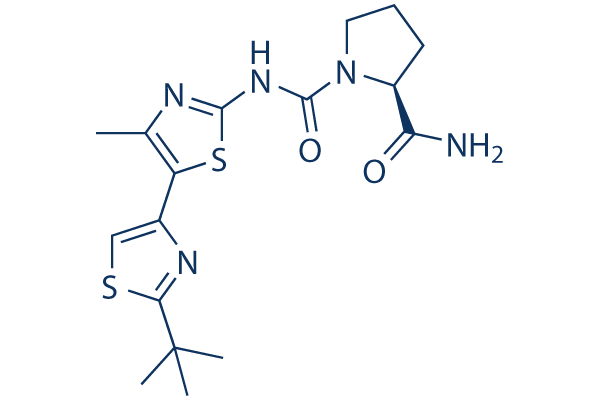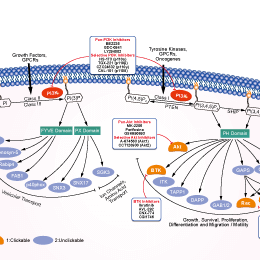
- Bioactive Compounds
- By Signaling Pathways
- PI3K/Akt/mTOR
- Epigenetics
- Methylation
- Immunology & Inflammation
- Protein Tyrosine Kinase
- Angiogenesis
- Apoptosis
- Autophagy
- ER stress & UPR
- JAK/STAT
- MAPK
- Cytoskeletal Signaling
- Cell Cycle
- TGF-beta/Smad
- DNA Damage/DNA Repair
- Compound Libraries
- Popular Compound Libraries
- Customize Library
- Clinical and FDA-approved Related
- Bioactive Compound Libraries
- Inhibitor Related
- Natural Product Related
- Metabolism Related
- Cell Death Related
- By Signaling Pathway
- By Disease
- Anti-infection and Antiviral Related
- Neuronal and Immunology Related
- Fragment and Covalent Related
- FDA-approved Drug Library
- FDA-approved & Passed Phase I Drug Library
- Preclinical/Clinical Compound Library
- Bioactive Compound Library-I
- Bioactive Compound Library-Ⅱ
- Kinase Inhibitor Library
- Express-Pick Library
- Natural Product Library
- Human Endogenous Metabolite Compound Library
- Alkaloid Compound LibraryNew
- Angiogenesis Related compound Library
- Anti-Aging Compound Library
- Anti-alzheimer Disease Compound Library
- Antibiotics compound Library
- Anti-cancer Compound Library
- Anti-cancer Compound Library-Ⅱ
- Anti-cancer Metabolism Compound Library
- Anti-Cardiovascular Disease Compound Library
- Anti-diabetic Compound Library
- Anti-infection Compound Library
- Antioxidant Compound Library
- Anti-parasitic Compound Library
- Antiviral Compound Library
- Apoptosis Compound Library
- Autophagy Compound Library
- Calcium Channel Blocker LibraryNew
- Cambridge Cancer Compound Library
- Carbohydrate Metabolism Compound LibraryNew
- Cell Cycle compound library
- CNS-Penetrant Compound Library
- Covalent Inhibitor Library
- Cytokine Inhibitor LibraryNew
- Cytoskeletal Signaling Pathway Compound Library
- DNA Damage/DNA Repair compound Library
- Drug-like Compound Library
- Endoplasmic Reticulum Stress Compound Library
- Epigenetics Compound Library
- Exosome Secretion Related Compound LibraryNew
- FDA-approved Anticancer Drug LibraryNew
- Ferroptosis Compound Library
- Flavonoid Compound Library
- Fragment Library
- Glutamine Metabolism Compound Library
- Glycolysis Compound Library
- GPCR Compound Library
- Gut Microbial Metabolite Library
- HIF-1 Signaling Pathway Compound Library
- Highly Selective Inhibitor Library
- Histone modification compound library
- HTS Library for Drug Discovery
- Human Hormone Related Compound LibraryNew
- Human Transcription Factor Compound LibraryNew
- Immunology/Inflammation Compound Library
- Inhibitor Library
- Ion Channel Ligand Library
- JAK/STAT compound library
- Lipid Metabolism Compound LibraryNew
- Macrocyclic Compound Library
- MAPK Inhibitor Library
- Medicine Food Homology Compound Library
- Metabolism Compound Library
- Methylation Compound Library
- Mouse Metabolite Compound LibraryNew
- Natural Organic Compound Library
- Neuronal Signaling Compound Library
- NF-κB Signaling Compound Library
- Nucleoside Analogue Library
- Obesity Compound Library
- Oxidative Stress Compound LibraryNew
- Plant Extract Library
- Phenotypic Screening Library
- PI3K/Akt Inhibitor Library
- Protease Inhibitor Library
- Protein-protein Interaction Inhibitor Library
- Pyroptosis Compound Library
- Small Molecule Immuno-Oncology Compound Library
- Mitochondria-Targeted Compound LibraryNew
- Stem Cell Differentiation Compound LibraryNew
- Stem Cell Signaling Compound Library
- Natural Phenol Compound LibraryNew
- Natural Terpenoid Compound LibraryNew
- TGF-beta/Smad compound library
- Traditional Chinese Medicine Library
- Tyrosine Kinase Inhibitor Library
- Ubiquitination Compound Library
-
Cherry Picking
You can personalize your library with chemicals from within Selleck's inventory. Build the right library for your research endeavors by choosing from compounds in all of our available libraries.
Please contact us at [email protected] to customize your library.
You could select:
- Antibodies
- Bioreagents
- qPCR
- 2x SYBR Green qPCR Master Mix
- 2x SYBR Green qPCR Master Mix(Low ROX)
- 2x SYBR Green qPCR Master Mix(High ROX)
- Protein Assay
- Protein A/G Magnetic Beads for IP
- Anti-Flag magnetic beads
- Anti-Flag Affinity Gel
- Anti-Myc magnetic beads
- Anti-HA magnetic beads
- Magnetic Separator
- Poly DYKDDDDK Tag Peptide lyophilized powder
- Protease Inhibitor Cocktail
- Protease Inhibitor Cocktail (EDTA-Free, 100X in DMSO)
- Phosphatase Inhibitor Cocktail (2 Tubes, 100X)
- Cell Biology
- Cell Counting Kit-8 (CCK-8)
- Animal Experiment
- Mouse Direct PCR Kit (For Genotyping)
- New Products
- Contact Us
A66
A66 is a potent and specific p110α inhibitor with IC50 of 32 nM in a cell-free assay, >100 fold selectivity for p110α over other class-I PI3K isoforms.

A66 Chemical Structure
CAS No. 1166227-08-2
Purity & Quality Control
Batch:
Purity:
99.82%
99.82
A66 Related Products
Signaling Pathway
Biological Activity
| Description | A66 is a potent and specific p110α inhibitor with IC50 of 32 nM in a cell-free assay, >100 fold selectivity for p110α over other class-I PI3K isoforms. | ||||||||
|---|---|---|---|---|---|---|---|---|---|
| Features | Highly selective for the p110α isoform. | ||||||||
| Targets |
|
| In vitro | ||||
| In vitro | In addition to the wild-type p110α, A66 also potently inhibits the oncogenic forms of p110α such as p110α E545K and p110α H1047R with IC50 of 30 nM and 43 nM, respectively. Unlike PIK-75, A66 displays >100 fold selectivity for p110α over other class-I PI3K isoforms. Among the class-II PI3Ks, class-III PI3K and PI4Ks, A66 only exhibits limited cross-reactivity with the class-II PI3K PI3KC2β and the PI4Kβ isoform of PI4K with IC50 of 462 nM and 236 nM, respectively. A66 exhibits no inhibitory activity against other lipid kinases or the related kinases DNA-PK and mTOR. A66 has a higher degree of specificity compared with PIK-75 when tested at 10 μM against two large panels of 110 protein kinases and 318 kinases. Inhibition of p110α alone by A66 treatment is sufficient to block insulin signalling to Akt/PKB in certain cell lines that harbor H1047R mutations in PIK3CA and have high levels of p110α and class-Ia PI3K activity. [1] A66 treatment at 0.7 μM induces a 75-80% reduction in focus formation by the highly transforming p85α iSH2 mutants KS459delN, DKRMN-S560del, and K379E, and reduces the phosphorylation of Akt on T308 by all p85 mutants. [2] | |||
|---|---|---|---|---|
| In Vivo | ||
| In vivo | A single dose of A66 at 100 mg/kg induces a profound reduction in the phosphorylation of Akt/PKB and p70 S6 kinase, but not of ERK, in SK-OV-3 tumour tissue in vivo at both 1 hour and 6 hours after dosing. A66 dosed at 100 mg/kg once daily (QD) for 21 days or 75 mg/kg twice daily (BID) for 16 days induces a significant delay in growth of SK-OV-3 xenografted tumors with average TGI of 45.9% and 29.9%, respectively, which is even greater than that induced by the well-established pan-PI3K inhibitor BEZ-235. QD dosing of A66 in the HCT-116 xenograft model also induces a significant reduction in tumour volume with TGI of 77.2%, but causes a non-significant reduction in tumor volume in the U87MG xenograft model. [1] Administration of A66 at 10 mg/kg in male CD1 mice induces significant impairments in the ITT (insulin tolerance test) and GTT (glucose tolerance test), and an increase in glucose production during a PTT (pyruvate tolerance test), almost to the same level as the pan-PI3K inhibitors. [3] | |
|---|---|---|
| Animal Research | Animal Models | Age-matched specific pathogen-free Rag1-/- or NIH-III mice inoculated subcutaneously with U87MG, SK-OV-3 or HCT-116 cells |
| Dosages | 100 mg/kg once daily (QD) or 75 mg/kg twice daily (BID) | |
| Administration | Intraperitoneal injection | |
| NCT Number | Recruitment | Conditions | Sponsor/Collaborators | Start Date | Phases |
|---|---|---|---|---|---|
| NCT01046383 | Terminated | NON-SMALL CELL LUNG CANCER |
Immunotec Inc. |
June 2010 | Phase 3 |
Chemical Information & Solubility
| Molecular Weight | 393.53 | Formula | C17H23N5O2S2 |
| CAS No. | 1166227-08-2 | SDF | Download A66 SDF |
| Smiles | CC1=C(SC(=N1)NC(=O)N2CCCC2C(=O)N)C3=CSC(=N3)C(C)(C)C | ||
| Storage (From the date of receipt) | |||
|
In vitro |
DMSO : 79 mg/mL ( (200.74 mM) Moisture-absorbing DMSO reduces solubility. Please use fresh DMSO.) Ethanol : 1 mg/mL Water : Insoluble |
Molecular Weight Calculator |
|
In vivo Add solvents to the product individually and in order. |
In vivo Formulation Calculator |
||||
Preparing Stock Solutions
Molarity Calculator
In vivo Formulation Calculator (Clear solution)
Step 1: Enter information below (Recommended: An additional animal making an allowance for loss during the experiment)
mg/kg
g
μL
Step 2: Enter the in vivo formulation (This is only the calculator, not formulation. Please contact us first if there is no in vivo formulation at the solubility Section.)
% DMSO
%
% Tween 80
% ddH2O
%DMSO
%
Calculation results:
Working concentration: mg/ml;
Method for preparing DMSO master liquid: mg drug pre-dissolved in μL DMSO ( Master liquid concentration mg/mL, Please contact us first if the concentration exceeds the DMSO solubility of the batch of drug. )
Method for preparing in vivo formulation: Take μL DMSO master liquid, next addμL PEG300, mix and clarify, next addμL Tween 80, mix and clarify, next add μL ddH2O, mix and clarify.
Method for preparing in vivo formulation: Take μL DMSO master liquid, next add μL Corn oil, mix and clarify.
Note: 1. Please make sure the liquid is clear before adding the next solvent.
2. Be sure to add the solvent(s) in order. You must ensure that the solution obtained, in the previous addition, is a clear solution before proceeding to add the next solvent. Physical methods such
as vortex, ultrasound or hot water bath can be used to aid dissolving.
Tech Support
Answers to questions you may have can be found in the inhibitor handling instructions. Topics include how to prepare stock solutions, how to store inhibitors, and issues that need special attention for cell-based assays and animal experiments.
Tel: +1-832-582-8158 Ext:3
If you have any other enquiries, please leave a message.
* Indicates a Required Field
Tags: buy A66 | A66 supplier | purchase A66 | A66 cost | A66 manufacturer | order A66 | A66 distributor







































